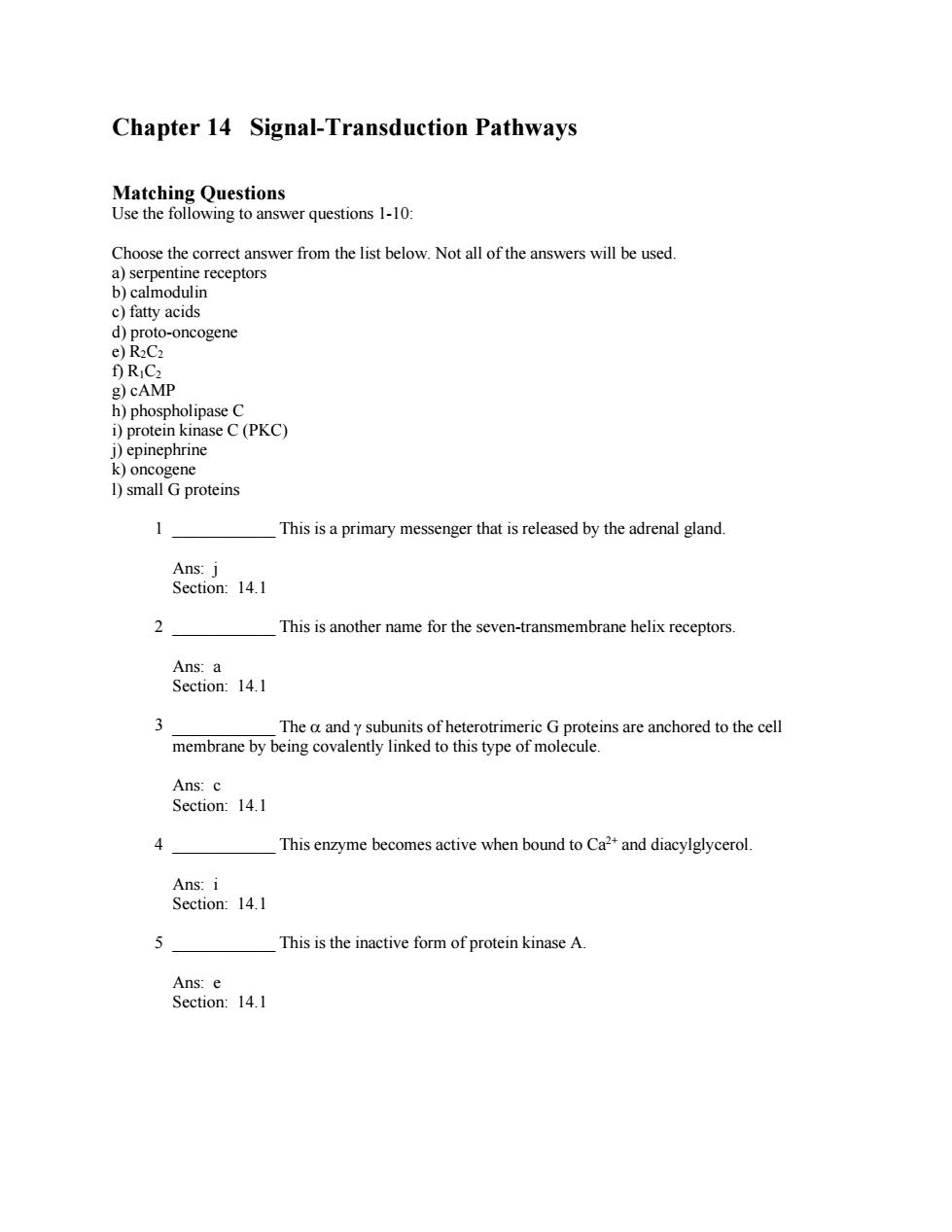
Chapter 14 Signal-Transduction Pathways Matching Questions Use the following to answer questions 1-10: Choose the correct answer from the list below.Not all of the answers will be used a)serpentine receptors b)calmodulin c)fatty acids d)proto-oncogene e)R2C2 f)RC2 g)cAMP h)phospholipase C i)protein kinase C(PKC) j)epinephrine k)oncogene 1)small G proteins 1 This is a primary messenger that is released by the adrenal gland. Ans:j Section:14.1 2 This is another name for the seven-transmembrane helix receptors Ans:a Section:14.1 The a and y subunits of heterotrimeric G proteins are anchored to the cell membrane by being covalently linked to this type of molecule. Ans:c Section:14.1 This enzyme becomes active when bound to Ca2+and diacylglycerol Ans:i Section:14.1 5 This is the inactive form of protein kinase A. Ans:e Section:14.1
Chapter 14 Signal-Transduction Pathways Matching Questions Use the following to answer questions 1-10: Choose the correct answer from the list below. Not all of the answers will be used. a) serpentine receptors b) calmodulin c) fatty acids d) proto-oncogene e) R2C2 f) R1C2 g) cAMP h) phospholipase C i) protein kinase C (PKC) j) epinephrine k) oncogene l) small G proteins 1 ____________ This is a primary messenger that is released by the adrenal gland. Ans: j Section: 14.1 2 ____________ This is another name for the seven-transmembrane helix receptors. Ans: a Section: 14.1 3 ____________ The and subunits of heterotrimeric G proteins are anchored to the cell membrane by being covalently linked to this type of molecule. Ans: c Section: 14.1 4 ____________ This enzyme becomes active when bound to Ca 2+ and diacylglycerol. Ans: i Section: 14.1 5 ____________ This is the inactive form of protein kinase A. Ans: e Section: 14.1
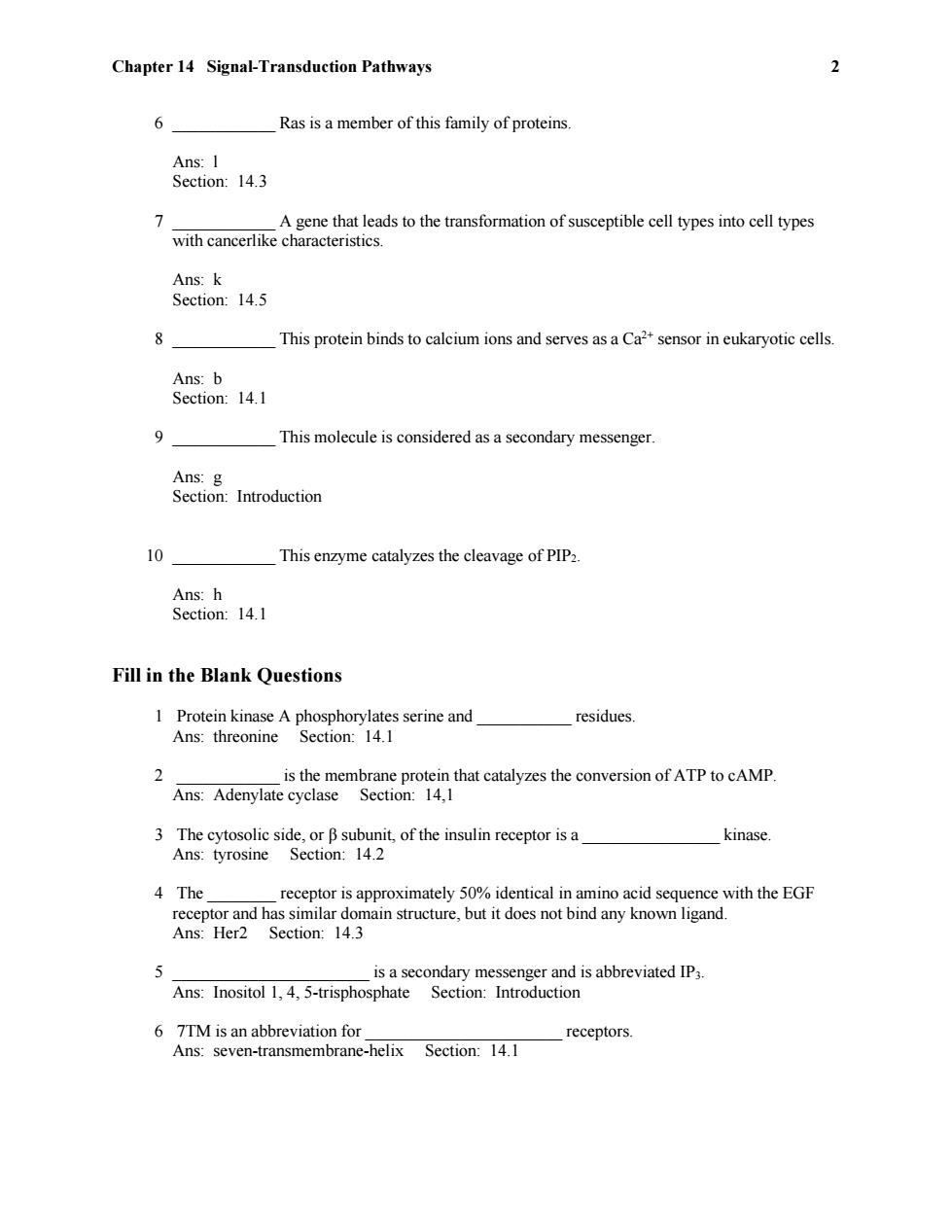
Chapter 14 Signal-Transduction Pathways 2 6 Ras is a member of this family of proteins. Ans:I Section:14.3 7 A gene that leads to the transformation of susceptible cell types into cell types with cancerlike characteristics. Ans:k Section:14.5 8 This protein binds to calcium ions and serves as a Ca2+sensor in eukaryotic cells. Ans:b Section:14.1 9 This molecule is considered as a secondary messenger. Ans:g Section:Introduction 10 This enzyme catalyzes the cleavage of PIP2. Ans:h Section:14.1 Fill in the Blank Questions 1 Protein kinase A phosphorylates serine and residues. Ans:threonine Section:14.1 2 is the membrane protein that catalyzes the conversion of ATP to cAMP. Ans:Adenylate cyclase Section:14,1 3 The cytosolic side,or B subunit,of the insulin receptor is a kinase. Ans:tyrosine Section:14.2 4 The receptor is approximately 50%identical in amino acid sequence with the EGF receptor and has similar domain structure,but it does not bind any known ligand. Ans:Her2 Section:14.3 is a secondary messenger and is abbreviated IP3. Ans:Inositol 1,4,5-trisphosphate Section:Introduction 6 7TM is an abbreviation for receptors. Ans:seven-transmembrane-helix Section:14.1
Chapter 14 Signal-Transduction Pathways 2 6 ____________ Ras is a member of this family of proteins. Ans: l Section: 14.3 7 ____________ A gene that leads to the transformation of susceptible cell types into cell types with cancerlike characteristics. Ans: k Section: 14.5 8 ____________ This protein binds to calcium ions and serves as a Ca 2+ sensor in eukaryotic cells. Ans: b Section: 14.1 9 ____________ This molecule is considered as a secondary messenger. Ans: g Section: Introduction 10 ____________ This enzyme catalyzes the cleavage of PIP2. Ans: h Section: 14.1 Fill in the Blank Questions 1 Protein kinase A phosphorylates serine and ___________ residues. Ans: threonine Section: 14.1 2 ____________ is the membrane protein that catalyzes the conversion of ATP to cAMP. Ans: Adenylate cyclase Section: 14,1 3 The cytosolic side, or β subunit, of the insulin receptor is a ________________ kinase. Ans: tyrosine Section: 14.2 4 The ________ receptor is approximately 50% identical in amino acid sequence with the EGF receptor and has similar domain structure, but it does not bind any known ligand. Ans: Her2 Section: 14.3 5 _______________________ is a secondary messenger and is abbreviated IP3. Ans: Inositol 1, 4, 5-trisphosphate Section: Introduction 6 7TM is an abbreviation for _______________________ receptors. Ans: seven-transmembrane-helix Section: 14.1
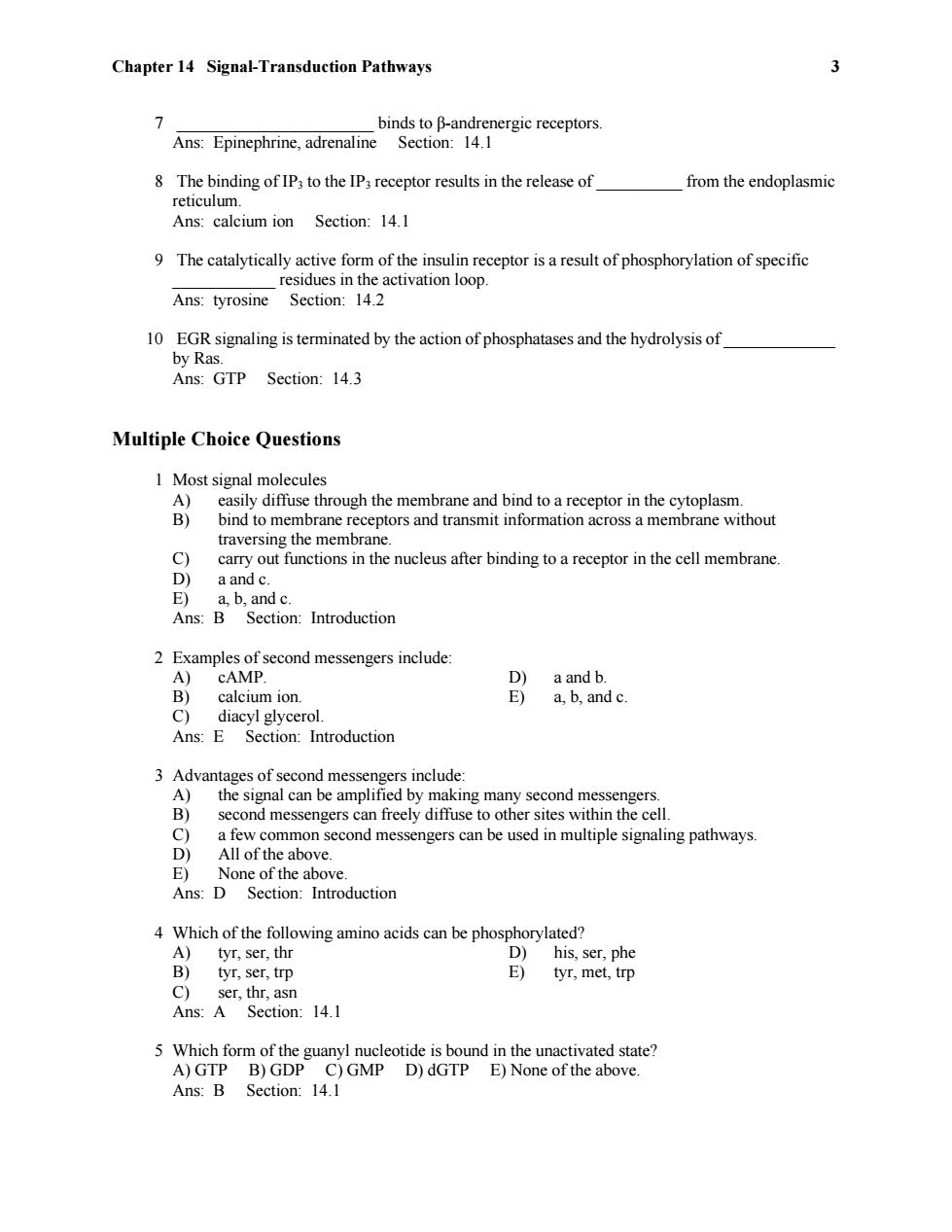
Chapter 14 Signal-Transduction Pathways 3 7 binds to B-andrenergic receptors. Ans:Epinephrine,adrenaline Section:14.1 8 The binding of IP3 to the IP,receptor results in the release of from the endoplasmic reticulum. Ans:calcium ion Section:14.1 9 The catalytically active form of the insulin receptor is a result of phosphorylation of specific residues in the activation loop. Ans:tyrosine Section:14.2 10 EGR signaling is terminated by the action of phosphatases and the hydrolysis of by Ras. Ans:GTP Section:14.3 Multiple Choice Questions 1 Most signal molecules A) easily diffuse through the membrane and bind to a receptor in the cytoplasm. B) bind to membrane receptors and transmit information across a membrane without traversing the membrane. C) carry out functions in the nucleus after binding to a receptor in the cell membrane. D) a and c. E) a,b,and c. Ans:B Section:Introduction 2 Examples of second messengers include: A) cAMP D) a and b. B) calcium ion. E) a.b.and c. C) diacyl glycerol Ans:E Section:Introduction 3 Advantages of second messengers include: A) the signal can be amplified by making many second messengers. B) second messengers can freely diffuse to other sites within the cell. c) a few common second messengers can be used in multiple signaling pathways. D) All of the above. E)None of the above. Ans:D Section:Introduction 4 Which of the following amino acids can be phosphorylated? A)tyr,ser,thr D)his,ser,phe B)tyr,ser,trp E)tyr,met,trp C)ser,thr,asn Ans:A Section:14.1 5 Which form of the guanyl nucleotide is bound in the unactivated state? A)GTP B)GDP C)GMP D)dGTP E)None of the above. Ans:B Section:14.1
Chapter 14 Signal-Transduction Pathways 3 7 _______________________ binds to β-andrenergic receptors. Ans: Epinephrine, adrenaline Section: 14.1 8 The binding of IP3 to the IP3 receptor results in the release of __________ from the endoplasmic reticulum. Ans: calcium ion Section: 14.1 9 The catalytically active form of the insulin receptor is a result of phosphorylation of specific ____________ residues in the activation loop. Ans: tyrosine Section: 14.2 10 EGR signaling is terminated by the action of phosphatases and the hydrolysis of _____________ by Ras. Ans: GTP Section: 14.3 Multiple Choice Questions 1 Most signal molecules A) easily diffuse through the membrane and bind to a receptor in the cytoplasm. B) bind to membrane receptors and transmit information across a membrane without traversing the membrane. C) carry out functions in the nucleus after binding to a receptor in the cell membrane. D) a and c. E) a, b, and c. Ans: B Section: Introduction 2 Examples of second messengers include: A) cAMP. D) a and b. B) calcium ion. E) a, b, and c. C) diacyl glycerol. Ans: E Section: Introduction 3 Advantages of second messengers include: A) the signal can be amplified by making many second messengers. B) second messengers can freely diffuse to other sites within the cell. C) a few common second messengers can be used in multiple signaling pathways. D) All of the above. E) None of the above. Ans: D Section: Introduction 4 Which of the following amino acids can be phosphorylated? A) tyr, ser, thr D) his, ser, phe B) tyr, ser, trp E) tyr, met, trp C) ser, thr, asn Ans: A Section: 14.1 5 Which form of the guanyl nucleotide is bound in the unactivated state? A) GTP B) GDP C) GMP D) dGTP E) None of the above. Ans: B Section: 14.1
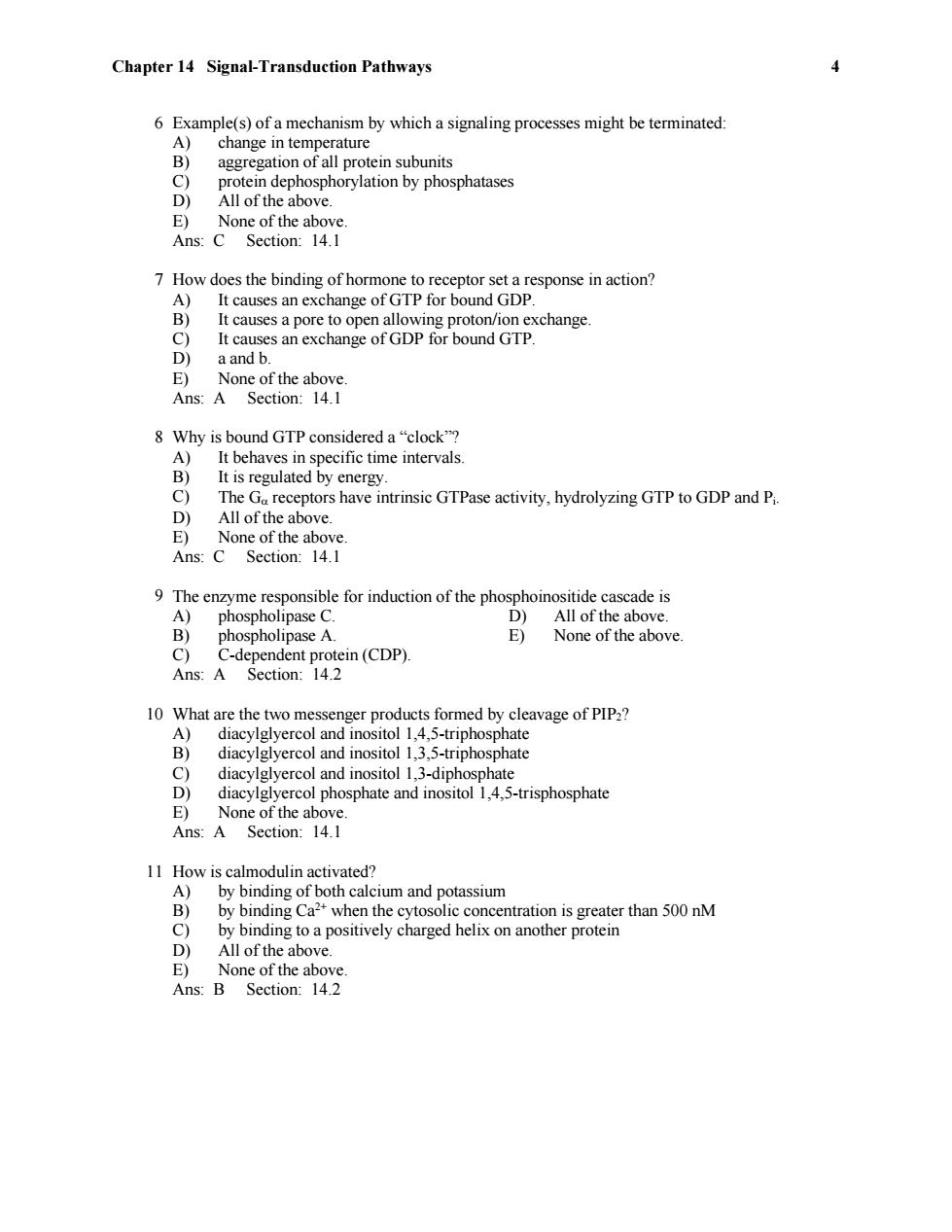
Chapter 14 Signal-Transduction Pathways 4 6 Example(s)of a mechanism by which a signaling processes might be terminated: A) change in temperature B) aggregation of all protein subunits c) protein dephosphorylation by phosphatases D All of the above. E) None of the above Ans:C Section:14.1 7 How does the binding of hormone to receptor set a response in action? A)It causes an exchange of GTP for bound GDP. B) It causes a pore to open allowing proton/ion exchange. C) It causes an exchange of GDP for bound GTP. D) a and b. E)None of the above. Ans:A Section:14.1 8 Why is bound GTP considered a"clock"? A)It behaves in specific time intervals. B) It is regulated by energy. C) The Ga receptors have intrinsic GTPase activity,hydrolyzing GTP to GDP and Pi. D) All of the above. E) None of the above. Ans:C Section:14.1 9 The enzyme responsible for induction of the phosphoinositide cascade is A) phospholipase C. D)All of the above. B) phospholipase A E) None of the above. C) C-dependent protein(CDP) Ans:A Section:14.2 10 What are the two messenger products formed by cleavage of PIP2? A) diacylglyercol and inositol 1,4,5-triphosphate B)diacylglyercol and inositol 1,3.5-triphosphate C) diacylglyercol and inositol 1,3-diphosphate D) diacylglyercol phosphate and inositol 1,4,5-trisphosphate E)None of the above. Ans:A Section:14.1 11 How is calmodulin activated? A)by binding of both calcium and potassium B)by binding Ca2+when the cytosolic concentration is greater than 500 nM C)by binding to a positively charged helix on another protein D)All of the above E)None of the above. Ans:B Section:14.2
Chapter 14 Signal-Transduction Pathways 4 6 Example(s) of a mechanism by which a signaling processes might be terminated: A) change in temperature B) aggregation of all protein subunits C) protein dephosphorylation by phosphatases D) All of the above. E) None of the above. Ans: C Section: 14.1 7 How does the binding of hormone to receptor set a response in action? A) It causes an exchange of GTP for bound GDP. B) It causes a pore to open allowing proton/ion exchange. C) It causes an exchange of GDP for bound GTP. D) a and b. E) None of the above. Ans: A Section: 14.1 8 Why is bound GTP considered a “clock”? A) It behaves in specific time intervals. B) It is regulated by energy. C) The G receptors have intrinsic GTPase activity, hydrolyzing GTP to GDP and Pi. D) All of the above. E) None of the above. Ans: C Section: 14.1 9 The enzyme responsible for induction of the phosphoinositide cascade is A) phospholipase C. D) All of the above. B) phospholipase A. E) None of the above. C) C-dependent protein (CDP). Ans: A Section: 14.2 10 What are the two messenger products formed by cleavage of PIP2? A) diacylglyercol and inositol 1,4,5-triphosphate B) diacylglyercol and inositol 1,3,5-triphosphate C) diacylglyercol and inositol 1,3-diphosphate D) diacylglyercol phosphate and inositol 1,4,5-trisphosphate E) None of the above. Ans: A Section: 14.1 11 How is calmodulin activated? A) by binding of both calcium and potassium B) by binding Ca 2+ when the cytosolic concentration is greater than 500 nM C) by binding to a positively charged helix on another protein D) All of the above. E) None of the above. Ans: B Section: 14.2
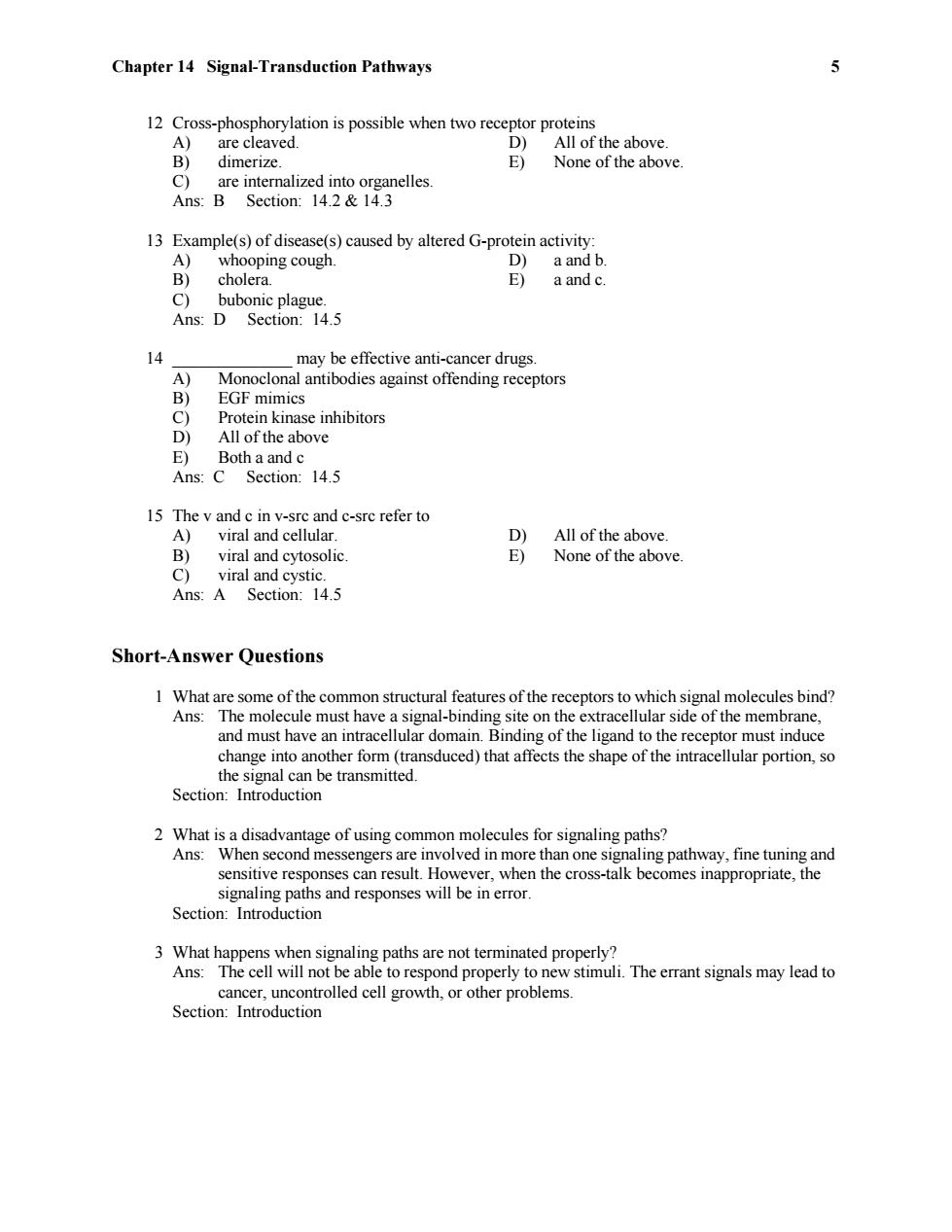
Chapter 14 Signal-Transduction Pathways 12 Cross-phosphorylation is possible when two receptor proteins A) are cleaved. D) All of the above. B) dimerize. E) None of the above. c) are internalized into organelles. Ans:B Section:14.2 &14.3 13 Example(s)of disease(s)caused by altered G-protein activity: A) whooping cough. D) a and b. B) cholera. E) a and c. C) bubonic plague. Ans:D Section:14.5 14 may be effective anti-cancer drugs. A) Monoclonal antibodies against offending receptors B) EGF mimics C) Protein kinase inhibitors D) All of the above E) Both a and c Ans:C Section:14.5 15 The v and c in v-src and c-src refer to A) viral and cellular. D) All of the above. B) viral and cytosolic E) None of the above. C) viral and cystic. Ans:A Section:14.5 Short-Answer Questions 1 What are some of the common structural features of the receptors to which signal molecules bind? Ans:The molecule must have a signal-binding site on the extracellular side of the membrane, and must have an intracellular domain.Binding of the ligand to the receptor must induce change into another form(transduced)that affects the shape of the intracellular portion,so the signal can be transmitted. Section:Introduction 2 What is a disadvantage of using common molecules for signaling paths? Ans:When second messengers are involved in more than one signaling pathway,fine tuning and sensitive responses can result.However,when the cross-talk becomes inappropriate,the signaling paths and responses will be in error. Section:Introduction 3 What happens when signaling paths are not terminated properly? Ans:The cell will not be able to respond properly to new stimuli.The errant signals may lead to cancer,uncontrolled cell growth,or other problems. Section:Introduction
Chapter 14 Signal-Transduction Pathways 5 12 Cross-phosphorylation is possible when two receptor proteins A) are cleaved. D) All of the above. B) dimerize. E) None of the above. C) are internalized into organelles. Ans: B Section: 14.2 & 14.3 13 Example(s) of disease(s) caused by altered G-protein activity: A) whooping cough. D) a and b. B) cholera. E) a and c. C) bubonic plague. Ans: D Section: 14.5 14 ______________ may be effective anti-cancer drugs. A) Monoclonal antibodies against offending receptors B) EGF mimics C) Protein kinase inhibitors D) All of the above E) Both a and c Ans: C Section: 14.5 15 The v and c in v-src and c-src refer to A) viral and cellular. D) All of the above. B) viral and cytosolic. E) None of the above. C) viral and cystic. Ans: A Section: 14.5 Short-Answer Questions 1 What are some of the common structural features of the receptors to which signal molecules bind? Ans: The molecule must have a signal-binding site on the extracellular side of the membrane, and must have an intracellular domain. Binding of the ligand to the receptor must induce change into another form (transduced) that affects the shape of the intracellular portion, so the signal can be transmitted. Section: Introduction 2 What is a disadvantage of using common molecules for signaling paths? Ans: When second messengers are involved in more than one signaling pathway, fine tuning and sensitive responses can result. However, when the cross-talk becomes inappropriate, the signaling paths and responses will be in error. Section: Introduction 3 What happens when signaling paths are not terminated properly? Ans: The cell will not be able to respond properly to new stimuli. The errant signals may lead to cancer, uncontrolled cell growth, or other problems. Section: Introduction
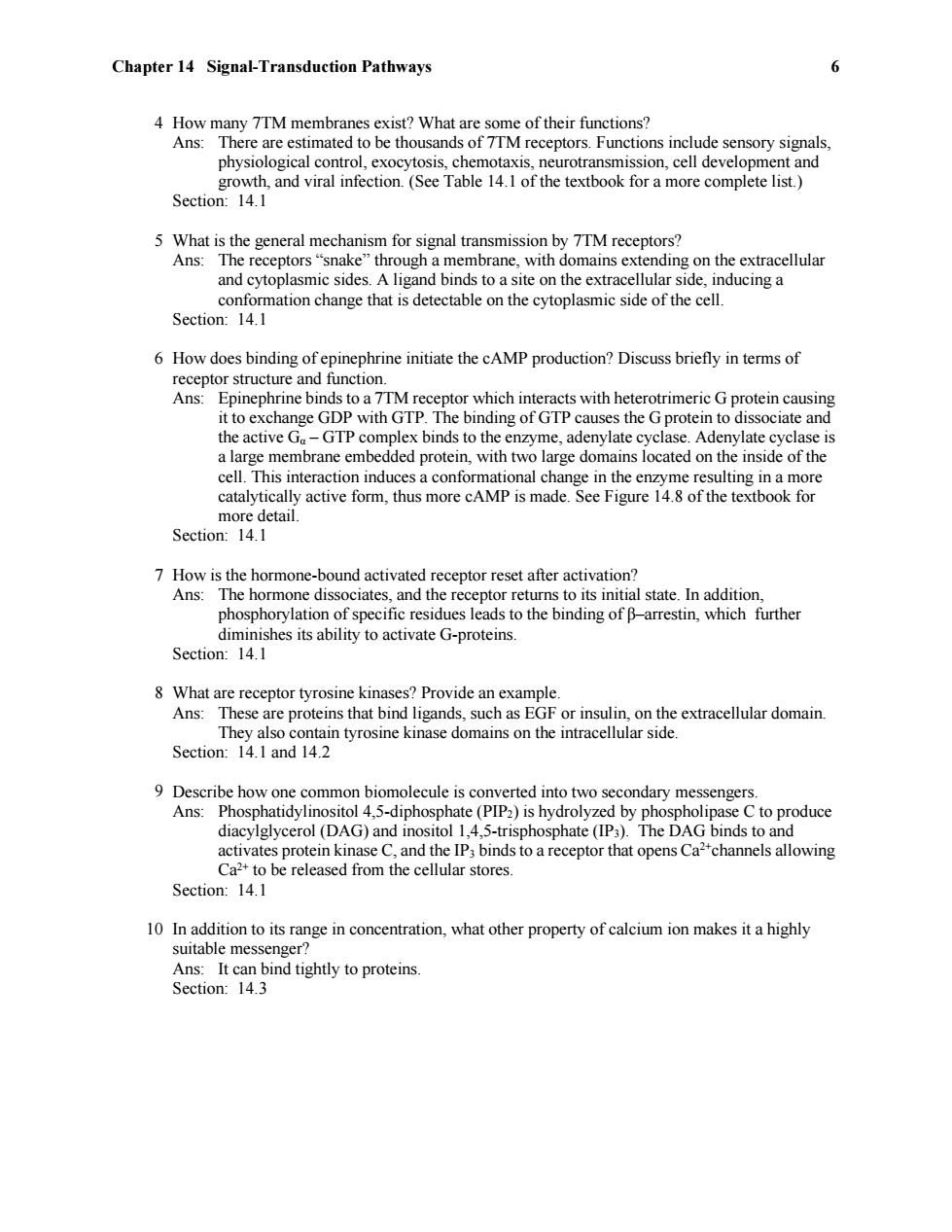
Chapter 14 Signal-Transduction Pathways 6 4 How many 7TM membranes exist?What are some of their functions? Ans:There are estimated to be thousands of 7TM receptors.Functions include sensory signals, physiological control,exocytosis,chemotaxis,neurotransmission,cell development and growth,and viral infection.(See Table 14.1 of the textbook for a more complete list.) Section:14.1 5 What is the general mechanism for signal transmission by 7TM receptors? Ans:The receptors"snake"through a membrane,with domains extending on the extracellular and cytoplasmic sides.A ligand binds to a site on the extracellular side,inducing a conformation change that is detectable on the cytoplasmic side of the cell. Section:14.1 6 How does binding of epinephrine initiate the cAMP production?Discuss briefly in terms of receptor structure and function. Ans:Epinephrine binds to a 7TM receptor which interacts with heterotrimeric G protein causing it to exchange GDP with GTP.The binding of GTP causes the G protein to dissociate and the active Ga-GTP complex binds to the enzyme,adenylate cyclase.Adenylate cyclase is a large membrane embedded protein,with two large domains located on the inside of the cell.This interaction induces a conformational change in the enzyme resulting in a more catalytically active form,thus more cAMP is made.See Figure 14.8 of the textbook for more detail. Section:14.1 7 How is the hormone-bound activated receptor reset after activation? Ans:The hormone dissociates,and the receptor returns to its initial state.In addition, phosphorylation of specific residues leads to the binding of B-arrestin,which further diminishes its ability to activate G-proteins. Section:14.1 8 What are receptor tyrosine kinases?Provide an example. Ans:These are proteins that bind ligands,such as EGF or insulin,on the extracellular domain. They also contain tyrosine kinase domains on the intracellular side. Section:14.1 and 14.2 9 Describe how one common biomolecule is converted into two secondary messengers. Ans:Phosphatidylinositol 4,5-diphosphate(PIP2)is hydrolyzed by phospholipase C to produce diacylglycerol(DAG)and inositol 1,4,5-trisphosphate(IP3).The DAG binds to and activates protein kinase C,and the IP3 binds to a receptor that opens Ca2*channels allowing Ca2+to be released from the cellular stores. Section:14.1 10 In addition to its range in concentration,what other property of calcium ion makes it a highly suitable messenger? Ans:It can bind tightly to proteins. Section:14.3
Chapter 14 Signal-Transduction Pathways 6 4 How many 7TM membranes exist? What are some of their functions? Ans: There are estimated to be thousands of 7TM receptors. Functions include sensory signals, physiological control, exocytosis, chemotaxis, neurotransmission, cell development and growth, and viral infection. (See Table 14.1 of the textbook for a more complete list.) Section: 14.1 5 What is the general mechanism for signal transmission by 7TM receptors? Ans: The receptors “snake” through a membrane, with domains extending on the extracellular and cytoplasmic sides. A ligand binds to a site on the extracellular side, inducing a conformation change that is detectable on the cytoplasmic side of the cell. Section: 14.1 6 How does binding of epinephrine initiate the cAMP production? Discuss briefly in terms of receptor structure and function. Ans: Epinephrine binds to a 7TM receptor which interacts with heterotrimeric G protein causing it to exchange GDP with GTP. The binding of GTP causes the G protein to dissociate and the active Gα – GTP complex binds to the enzyme, adenylate cyclase. Adenylate cyclase is a large membrane embedded protein, with two large domains located on the inside of the cell. This interaction induces a conformational change in the enzyme resulting in a more catalytically active form, thus more cAMP is made. See Figure 14.8 of the textbook for more detail. Section: 14.1 7 How is the hormone-bound activated receptor reset after activation? Ans: The hormone dissociates, and the receptor returns to its initial state. In addition, phosphorylation of specific residues leads to the binding of β–arrestin, which further diminishes its ability to activate G-proteins. Section: 14.1 8 What are receptor tyrosine kinases? Provide an example. Ans: These are proteins that bind ligands, such as EGF or insulin, on the extracellular domain. They also contain tyrosine kinase domains on the intracellular side. Section: 14.1 and 14.2 9 Describe how one common biomolecule is converted into two secondary messengers. Ans: Phosphatidylinositol 4,5-diphosphate (PIP2) is hydrolyzed by phospholipase C to produce diacylglycerol (DAG) and inositol 1,4,5-trisphosphate (IP3). The DAG binds to and activates protein kinase C, and the IP3 binds to a receptor that opens Ca 2+channels allowing Ca 2+ to be released from the cellular stores. Section: 14.1 10 In addition to its range in concentration, what other property of calcium ion makes it a highly suitable messenger? Ans: It can bind tightly to proteins. Section: 14.3

Chapter 14 Signal-Transduction Pathways 7 11 What is meant by an EF hand?Draw or describe the structure. Ans:The EF hand is a protein that binds calcium ions and contains a calcium ion-binding domain that contains a helix-loop-helix arrangement.The structure resembles a hand, index finger,and thumb extended,with the ion held near the palm by the middle finger Figure 14.15 of the textbook is an example of what a drawing of this structure may look like. Section:14.2 12 Give the reaction catalyzed by tyrosine kinase. Ans: OH 0-P032 ATP Tyrosine kinase Section:14.2 13 What is the relationship between monoclonal antibodies,breast cancer,and Her2? Ans:Her2 is a membrane protein that is very similar to the EGF receptor protein except it does not bind any known ligand.It can participate in cross-phosphorylation reaction with other receptors activating signaling pathways such as the EGF pathway.Her2 is overexpressed in about 30%of breast cancers.Monoclonal antibodies to Her2 have been used to treat cancers in these patients. Section:14.5 14 What is the difference between heterotrimeric G proteins and small G proteins? Ans:Heterotrimeric G proteins are composed of aBy subunits.The a subunit contains the guanyl nucleotide binding site.Upon activation by the signal-receptor event,the GDP is exchanged with a GTP,and the By subunits dissociate from the a bound with GTP,which is the form that activates adenyl cyclase.Small G proteins,such as ras,are single subunit proteins.They are activated by proteins such as Sos in the EGF signal pathway.The activation causes the exchange of GDP for GTP to convert it into an active kinase. Section:14.1 and 14.3 15 Describe two roles of phosphoinositol 4,5-bisphosphate (PIP2)in signal transduction. Ans:1.PIP2 is one of the signal molecules in the insulin pathway.It is converted into PIP3 by phoshoinositide 3-kinase.The binding of PIP3 activates PIP3-dependent protein kinase, which phosphorylates and activates other kinases in the pathway.2.PIP2 is also involved in another signal pathway that is activated by angiotensin2.The angiotensin2 receptor activates phospholipase C,which hydrolyses PIP2 to produce diacyl glycerol (DAG)and inositol 1,4,5-trisphosphate(IP3).The DAG binds to and activates protein kinase C,and the IP3 binds to an IP3 receptor that is also calcium ion channel.This opens the channel and calcium ions are released into the cytoplasm.The calcium ions bind to PKC and facilitate its activation. Section:14.1 and 14.2
Chapter 14 Signal-Transduction Pathways 7 11 What is meant by an EF hand? Draw or describe the structure. Ans: The EF hand is a protein that binds calcium ions and contains a calcium ion-binding domain that contains a helix-loop-helix arrangement. The structure resembles a hand, index finger, and thumb extended, with the ion held near the palm by the middle finger. Figure 14.15 of the textbook is an example of what a drawing of this structure may look like. Section: 14.2 12 Give the reaction catalyzed by tyrosine kinase. Ans: OH H C N O H H C N O H O PO3 -2 ATP ADP Tyrosine kinase Section: 14.2 13 What is the relationship between monoclonal antibodies, breast cancer, and Her2? Ans: Her2 is a membrane protein that is very similar to the EGF receptor protein except it does not bind any known ligand. It can participate in cross-phosphorylation reaction with other receptors activating signaling pathways such as the EGF pathway. Her2 is overexpressed in about 30% of breast cancers. Monoclonal antibodies to Her2 have been used to treat cancers in these patients. Section: 14.5 14 What is the difference between heterotrimeric G proteins and small G proteins? Ans: Heterotrimeric G proteins are composed of αβγ subunits. The α subunit contains the guanyl nucleotide binding site. Upon activation by the signal-receptor event, the GDP is exchanged with a GTP, and the βγ subunits dissociate from the α bound with GTP, which is the form that activates adenyl cyclase. Small G proteins, such as ras, are single subunit proteins. They are activated by proteins such as Sos in the EGF signal pathway. The activation causes the exchange of GDP for GTP to convert it into an active kinase. Section: 14.1 and 14.3 15 Describe two roles of phosphoinositol 4,5-bisphosphate (PIP2) in signal transduction. Ans: 1. PIP2 is one of the signal molecules in the insulin pathway. It is converted into PIP3 by phoshoinositide 3-kinase. The binding of PIP3 activates PIP3-dependent protein kinase, which phosphorylates and activates other kinases in the pathway. 2. PIP2 is also involved in another signal pathway that is activated by angiotensin2. The angiotensin2 receptor activates phospholipase C, which hydrolyses PIP2 to produce diacyl glycerol (DAG) and inositol 1,4,5-trisphosphate (IP3). The DAG binds to and activates protein kinase C, and the IP3 binds to an IP3 receptor that is also calcium ion channel. This opens the channel and calcium ions are released into the cytoplasm. The calcium ions bind to PKC and facilitate its activation. Section: 14.1 and 14.2